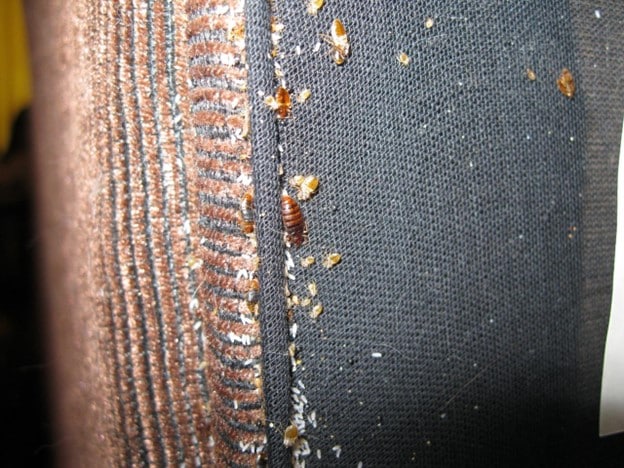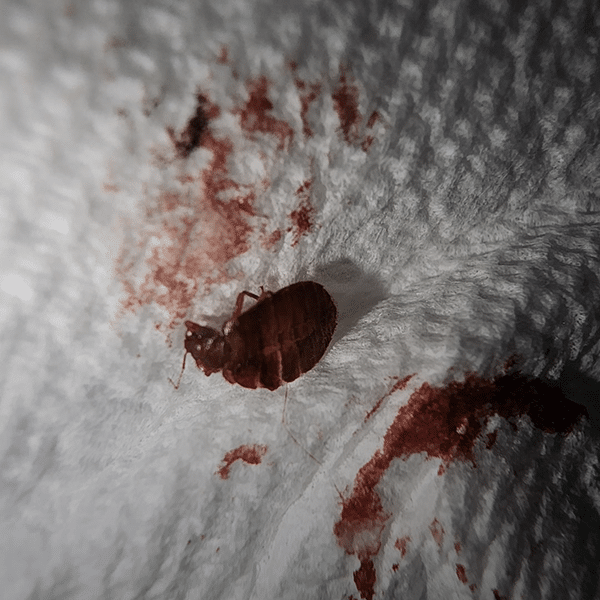
In the article
Waking up in a bed with bugs is a concerning and scary feeling for most people. Find out how to check for bed bugs and where to look to find them.
Telltale Signs of a Bed with Bugs
Catching bed bugs early is key to kicking them out for good. Sure, bites on your skin might make you think of bed bugs, but they can be confused with bites from other bugs or even skin issues like rashes or hives. Some folks don’t react to bed bug bites at all. So, let’s look at more solid clues.
What to Look For:
- Blood Stains: Tiny blood spots on your sheets or pillowcases.
- Dark Spots: Bed bug poop looks like little dark dots, often in clusters.
- Egg Shells and Shed Skins: You’ll find these where bed bugs like to hide.
- Live Bed Bugs: If you see them crawling around, you’ve got a problem.

Squashed Bed Bug
For a closer look at the first signs of bed bugs, check out our detailed article.
Bed Bug Behavior and Traits
Knowing how bed bugs act and what they look like helps you spot and deal with them. These little night stalkers feed on human blood and sometimes other mammals. They’re drawn to body heat and the carbon dioxide we breathe out.
Bed Bug Basics:
- Looks: Bed bugs are tiny and oval-shaped. Baby bed bugs (nymphs) are almost see-through but turn dark brown after eating.
- Feeding: They prefer to bite exposed skin, like shoulders and arms. They usually feed at night but can bite during the day if they’re hungry.
- Movement: Bed bugs can’t fly, only crawl. Sometimes, they drop from high places.
- Reproduction: Bed bugs breed fast. Females bedbugs can lay up to five eggs a day. Eggs hatch in about a week, and nymphs grow up in a month if conditions are right.
Table: Bed Bug Traits
| Trait | Description |
|---|---|
| Size | 1-7mm, depending on age |
| Color | Translucent (nymphs), Dark Brown (adults) |
| Feeding Time | Mostly night |
| Hosts | Humans, sometimes pets |
| Life Span | 12-18 months |
By getting to know these signs and behaviors, you can do a thorough bed bug check and take steps to get rid of them and keep them away.
Bed With Bugs Hiding Spots
Knowing where bed bugs like to hang out is crucial for spotting and getting rid of them. These sneaky critters are masters at hiding, making it tough to kick them out for good.
Favorite Bed Bug Hiding Spots
Bed bugs love to tuck themselves away in tiny, hidden places. They usually stay close to their food source (you), which is why they often crash in and around beds. Here are some of their favorite spots:
- Mattresses: Near the seams, piping, and tags.
- Bed Bases: In cracks and crevices.
- Bed Frames and Headboards: In joints and screws.
- Furniture: Inside upholstery and cushions.
- Luggage and Clothing: Often hitching a ride from infested places.
- High Turnover Areas: Hotels, motels, hostels, shelters, and apartment complexes.
In rooms with heavy infestations, bed bugs might also be found in:
- Electrical Outlets
- Wall Cracks
- Behind Picture Frames
- Under Carpets

Bed Bug Infestation
For more info on spotting the first signs of bed bugs, check out our detailed guide.
Battling Bed Bugs on Mattresses
Mattress Treatment Methods
Getting rid of bedbugs on your mattress isn’t a one-and-done deal. You need a mix of strategies to really tackle the problem. Here are some tried-and-true methods:
- Mattress Cover: Wrap your mattress in a top-notch cover to trap any bed bugs inside and keep new ones out. This works best when you use it alongside other treatments.
- Steaming: Blast the entire bed frame and mattress with a steamer for bed bugs. Heat will kill bedbugs and their eggs. It’s like a sauna they can’t survive.
- Diatomaceous Earth: Sprinkle this natural insecticide on your bed frame. It dehydrates and kills bed bugs on contact. For more details, check out our article on diatomaceous earth bed bugs.
- Vacuuming: Regularly vacuum your mattress and the surrounding area. Make sure to get into seams, folds, and other nooks where bed bugs like to hide.
- Heat Treatment: Expose the mattress to high temperatures using professional heat treatments or a portable bed bug heater. Bed bugs can’t handle temps above 49°C (120°F).
Preventative Measures for Bed with Bugs
Stopping bed bugs before they invade is key. Here are some tips to keep them at bay:
- Bed Bug Covers: Cover both the mattress and base of ensemble beds. Stand the base on its end, remove the wheels, and cover it up to block hiding spots.
- Screw-in Barriers and Floor Barriers: Install these barriers to stop bed bugs from climbing onto the bed. Keep the bed at least 30cm away from walls and other furniture.
- Regular Inspections: Check your bed often for bed bugs first signs like tiny blood stains, dark spots (bed bug poop), and shed skins.
- Luggage and Clothing: Bed bugs love to hitch rides in your luggage and clothes. After traveling, inspect and wash everything at high temperatures to kill any stowaways.
- Maintain Hygiene: Keep things clean to discourage bed bugs. They’re common in places with lots of people coming and going, like hotels and shelters. Regularly wash bedding, vacuum carpets, and declutter to reduce hiding spots.
- Diatomaceous Earth: DE ( Bed Bug Killer Dust) on the bed frame, It continues to kill bed bugs for years unless its removed.
How To Install A Bed Bug Cover
Bed Bug Traps and Monitors
Traps and monitors can help confirm if you have bed bugs. These gadgets use stuff like lactic acid, carbon dioxide, or pheromones to lure bed bugs into a container.
Types of Traps
- Passive Monitors: These sit near your bed and don’t use attractants. They rely on bed bugs’ natural behavior to crawl in.
- Active Monitors: These use attractants like heat, carbon dioxide, and pheromones to draw bed bugs into the trap.
Check out our bed bug trap tests to see who sells the best traps in Australia.
How to Get Rid of Bed Bugs On A Bed Frame
If you think you have a bed with bugs, don’t panic, we have the perfect bed bug treatment for you.
DIY Treatment For A Bed Frame
Keep Bed Bugs Away Permanently
Simple Steps to Stay Bed Bug-Free
Nobody wants to share their bed with creepy crawlies. Here’s how to keep those pesky bed bugs away:
- Check Your Stuff: Regularly inspect your mattress, bed frame, and nearby furniture. Look for tiny reddish-brown spots, shed skins, or live bugs.
- Keep It Clean: While bed bugs don’t care about dirt, a clean home helps you spot them faster. Vacuum often and wash your bedding in hot water.
- Cover Up: Use protective covers on your mattresses and base. These covers trap bed bugs and keep them from getting in or out.
- Seal the Gaps: Bed bugs love tiny spaces. Seal cracks in your walls, floors, and furniture to cut down on their hiding spots.
- Second-Hand Caution: Be extra careful with used furniture. Inspect it thoroughly before bringing it home. Bed bugs love second-hand items.
- Diatomaceous Earth: Sprinkle this natural powder around bed frames and other hiding spots. It’s a great deterrent. Find out more about diatomaceous earth for bed bugs.
After Travel Tips
Traveling can bring unwanted guests home. Here’s how to avoid that:
- Check Your Luggage: Before you bring your bags inside, inspect them for bed bugs. Pay close attention to seams and pockets.
- Heat Your Clothes: Change clothes outside the house and toss them straight into the dryer on high heat for at least 30 minutes. This kills any bed bugs hiding in your clothes.
- Store Smart: Keep your luggage off the bed when not in use.
- Inspect Your Shoes: Bed bugs can hide in shoes too. Check them thoroughly before coming inside.
- Use Monitors and Traps: Set up bed bug monitors and traps around your bed and furniture to catch early signs of an infestation. Learn about bed bug monitors and traps.
- Call the Pros: If you dont mind poisonous chemicals in your home, hire a professional pest control service.
Following these tips can help you avoid the nightmare of a bed bug infestation.
Frequently Asked Question:
- Is it OK to sleep with bedbugs?
- It’s not ideal to sleep with bed bugs. The bites can cause discomfort, itching, and allergic reactions, and an infestation can lead to anxiety and insomnia. It’s important to address the issue promptly.
- How do I know if my bed has bed bugs?
- Look for small, red, itchy bites; rusty or reddish stains on sheets; tiny dark fecal spots; small, pale yellow eggs and shells; and live bugs in mattress seams, headboards, and bed frames.
- Are bed bugs a problem in Australia?
- Yes, bed bugs are a problem in Australia. Increased travel, pesticide resistance, and changes in pest control practices have led to a resurgence. Vigilance and prompt action with eco-friendly solutions are essential.
Sources:
Better Health (bedbugs), Epa (how to find bed bugs), Wikipedia (Bed bugs)



Leave a Reply